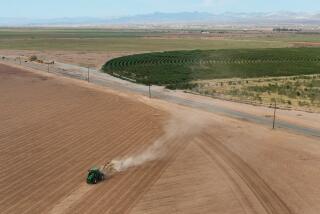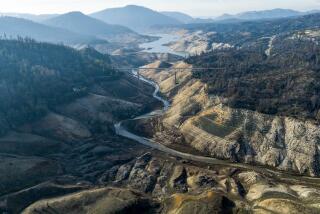El Nino May Skip This Year After All : Pacific Waters Near Equator Found Cooler
- Share via
The on-again, off-again phenomenon known as El Nino--the abnormally warm ocean current that wreaked global havoc three years ago, including a spate of intense winter storms that destroyed millions of dollars’ worth of property along the California coast--is apparently off for now, research scientists said Tuesday.
Some of those scientists, however, are not so sure; they say it may be better to wait until this fall before ruling out an El Nino later this year.
Just two months ago, weather scientists working independently in California, New York and Washington, D.C., said they had spotted some early signs of El Nino, including warmer temperatures in the Pacific Ocean off South America and a decrease in the trade winds along the Equator in the Pacific.
Relying on this information--which reflected conditions in December, January and February--the Climate Analysis Center of the National Oceanic and Atmospheric Administration, a federal agency, issued an El Nino advisory on March 13.
On Monday, in the face of new information indicating that temperatures in the Pacific are back to normal and in some cases cooler than usual, the Climate Analysis Center rescinded its advisory.
“It looks like the conditions are moderating . . . there seems to be no reason for a formal El Nino watch,” said Ants Leetmaa, an oceanographer at the Climate Analysis Center, in a telephone interview. He said that because of the severity of the El Nino of 1982-83, which disrupted weather patterns across three-fourths of the planet and caused several billion dollars’ damage and more than 800 deaths, weather scientists have been more watchful and want to avoid being taken by surprise, as many of them were four years ago when El Nino seemed to come out of nowhere.
“There was an early warning in 1986 that seemed to be significant” and led to the advisory, Leetmaa said. Along with the changes in water temperatures and wind ferocity were reports from scientists, for example, of a widespread failure in bird hatchings on the Galapagos Islands, a group of Pacific equatorial islands, caused by weather changes in early spring, he said.
“I don’t think the state of knowledge is such to (accurately) predict what will happen,” Leetmaa said. “Many of the (weather and computer) models are still primitive. We’re at a very preliminary state of discovering what causes these things to happen. We’re basically in a position to watch . . . and study the information.”
One of the leading indicators that a new El Nino isn’t on the way comes from a comprehensive system of charting Pacific Ocean temperatures. Dr. David Cutchin, a physical oceanographer at Scripps Institution of Oceanography in La Jolla, heads a program that uses 35 volunteer tanker and commercial ships that, while crisscrossing the sea, take temperature readings by using disposable 9-inch probes that descend to a depth of 1,500 feet.
Information gathered from these readings shows that “if anything, a set of anti-El Nino conditions exist,” Cutchin said in a telephone interview. Those conditions include strong trade winds in the equatorial region and normal to slightly cooler water temperatures in the Pacific along South America and in the subtropics.
Historically, Cutchin said, an El Nino has been preceded by warmer ocean temperatures off South America--particularly in Peru and Ecuador--and a slackening in the trade winds, conditions that existed earlier this year. The term El Nino is Spanish for “the Child,” and refers to Jesus because the weather condition generally begins in late December.
“The ocean is a sort of integrator (of all cumulative weather changes) . . . and everything now is close to normal,” Cutchin said. “From my viewpoint, there’s nothing there right now.”
Agreeing with that assessment is Stephen Zebiak, associate research scientist at Lamont-Doherty Geological Observatory at Columbia University. Zebiak and his colleague, Mark Cane, have developed a computer model that forecast a mild El Nino this coming winter.
“There’s no evidence of anything under way as of April,” Zebiak said in a telephone interview. He said his most recent computer model, using information through March, “was definitely less positive about an (El Nino) event.”
But Zebiak and another well-known research meteorologist, Dr. Jerome Namias, head of the Climate Research Group at Scripps, say it’s still possible that an El Nino could occur this coming winter.
“We’re not at the point where there’s no historical antecedent for an event this year,” Zebiak said, noting that that point should occur at the end of June. Namias, in a telephone interview, said much the same thing, except he added that it may take until September or October to predict with certainty what might happen.
“I haven’t given up the idea that an El Nino may be coming,” Namias said. “I still feel--although there are no immediate signs of a warning--that one could occur. It’s much too early to say it won’t.”
Both Zebiak and Namias said that past El Ninos have been preceded by normal or slightly cooler ocean temperatures. And all the scientists interviewed Tuesday said that if an El Nino does happen, it will probably be a mild one.
“The sad thing in this business,” Namias said, “is that no one has a handle on this, in the predictive sense. I will be the first to admit . . . the indications now are not as firm as they were then (March) about a recurrence.”
More to Read
Sign up for Essential California
The most important California stories and recommendations in your inbox every morning.
You may occasionally receive promotional content from the Los Angeles Times.













